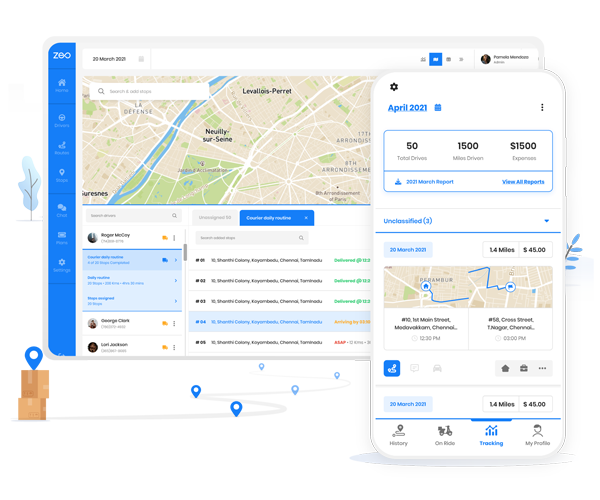An online retailer shipping hundreds of orders daily may lack storage, vehicles, or staff for smooth deliveries. Here, the third-party providers (3PL) step in, leveraging route planning and logistics tools to streamline the process.
The demand for 3PL is also bound to rise because customers demand fast, almost instant deliveries. A report by Grand View Research valued 3PL at $1.1 trillion in 2023 and projects that it will expand at an 8.1% CAGR through 2030.
The factors behind such growth are ecommerce expansion, advanced logistics technologies, and improved transport infrastructure across Asia and the Middle East.
Let’s explore in detail the definition of 3PL and how it works.
What is 3PL? How Does it Work?
Third-party logistics (3PL) is a technique that involves outsourcing logistics to an external provider. Here, the provider takes care of shipping, warehousing, packing, and other supply chain elements so that businesses don’t have to manage those activities in-house.
A 3PL partner has specialized expertise and resources, which reduces some of the company’s operational load. This might mean access to trucking fleets, advanced tracking software, or global distribution centers.
The key characteristics of 3PL include:
- Broad coverage across multiple regions and markets
- Management of inbound and outbound freight
- Advanced digital tools for shipment visibility
- Strong relationships with carriers and freight forwarders
- Adaptable cost structures based on business volumes
- Ability to handle customs and documentation when crossing borders
How 3PL Works?
Businesses providing 3PL services combine infrastructure, technology, and know-how to handle tasks ranging from receiving raw materials to delivering finished goods. They rely on solid networks of warehouses, fleets, and tools like Zeo Route Planner to navigate and optimize routes.
They also offer specialized freight options, such as ground shipping or full-blown air cargo. Some providers cater to narrow niches, while others run global operations that span multiple industries.
Everything is tied back to lower expenses, operational speed, and consistent customer service.
Below, we’ll explore major ways to find out how our 3PL works in the logistics and supply chain industry.
- Order Fulfillment and Warehousing
A 3PL provider often stores products in strategic locations and processes incoming orders on behalf of the client. This might include picking items from shelves, packing them safely, and handing them off to shipping carriers.
It’s a thorough process that demands accuracy, speed, and well-organized inventory systems. Many 3PL warehouses track every movement using barcode scanning through the warehouse and fulfilling part of the order management.It involves leveraging 3PL for the following:
- Centralized inventory control saves space for the client
- Automated systems help avoid mistakes in order processing
- Temperature-controlled units support products requiring special conditions
- Freight consolidation options minimize shipping costs
- Real-time stock data offers better forecasting capabilities
- Transportation and Freight Management
Moving goods from one point to another doesn’t just involve loading and unloading a truck. In fact, the service 3PL providers can arrange carrier contracts, negotiate shipping rates, and coordinate schedules to match sales volumes.They also monitor shipments in real time and adjust routes in case of delay. Many 3PL partners leverage track-and-trace platforms that offer immediate updates on each shipment’s status.
increase fuel savings
Save $200 on fuel, Monthly!
Optimize routes with our algorithm, reducing travel time and costs efficiently.
Get Started for FreeWith freight management and transportation, including last-mile delivery, the 3PL takes care of the following:
- Use of route optimization tools like Zeo Route Planner to reduce transit times
- Fleet managers and dispatchers can monitor vehicles in real-time, with automatic ETA adjustments for better shipment visibility
- Ensure dynamic route adjustments by making recalculations based on delays, roadblocks, or last-minute order changes to keep deliveries on track
- Automated notifications keep retailers and customers informed by collecting proof of delivery
- Customs Brokerage and International Shipping
Crossing borders introduces paperwork, tariffs, and regulations that can stall a shipment. A 3PL partner often handles those hurdles, guiding packages through customs checks and double-checking documents to avoid delays.Many providers monitor evolving trade rules to advise clients on the best routes or shipping methods. International commerce requires extra coordination and a clear understanding of fees.
When you opt for 3PL and look to leverage the services for international shipping and customs brokerage, here’s what you can expect:
- Negotiating with customs agents prevents miscommunication
- Proper classification of goods reduces the risk of fines
- Tax and duty calculations get streamlined by expert knowledge
- Local partnerships in different countries open up flexible delivery modes
- Real-time alerts inform businesses of any international shipping hold-ups
- Scalability and Seasonal Adjustments
Business activity often ebbs and flows, with holiday peaks and off-season lulls. A 3PL provider is prepared to accommodate those fluctuations by adjusting warehouse capacity, staff levels, and transportation routes.Such a level of flexibility keeps costs aligned with actual volume. Therefore, some businesses rely on these 3PL arrangements to test new markets without committing to permanent facilities.
Here’s what 3PL enables for such instance:
- Temporary storage expansions free up the client’s resources
- Flexible labor pools handle busy times without permanent hires
- Short-term contracts add agility for product launches or promotions
- Advanced forecasting tools project inventory requirements for each season
- Automated billing systems prevent billing confusion during volume changes
- Technology and Data Analytics
Software plays a big role in modern logistics, tracking shipments, managing drivers, enabling automated delivery updates, and much more.Businesses that use 3PL can monitor and flag anomalies in real time as they gain insight into shipment volumes, shipping costs, and delivery proofs. 3PL providers also use analytics dashboards to highlight patterns and pinpoint areas for improvement.
Implementing automation eliminates manual tasks so that staff can focus on more strategic decisions.
This is where Zeo Route Planner comes in to offer data analytics in the following areas:
- Cloud-based platform to keep data accessible from anywhere
- Real-time GPS tracking of drivers, along with automated proof of delivery (signatures, photos, timestamps)
- Automated alerts & exception handling to instantly notify businesses of delays, order issues, or route deviations
Conclusion
Organizations that want to offload storage, shipping, and returns can get more breathing room to refine their products and marketing. A 3PL arrangement acts like a hidden engine, quietly taking care of operational details while the main business shines at what it does best.
Zeo Route Planner can fill that role by offering tools for optimizing routes, reducing mileage costs, and handling core logistics chores. It becomes a plug-and-play solution for those who aspire to function as true 3PL providers on behalf of their clients.

Are you a fleet owner?
Want to manage your drivers and deliveries easily?
Grow your business effortlessly with Zeo Routes Planner – optimize routes and manage multiple drivers with ease.

increase fuel savings
Save 2 Hours on Deliveries, Everyday!
Optimize routes with our algorithm, reducing travel time and costs efficiently.
Get Started for Free























